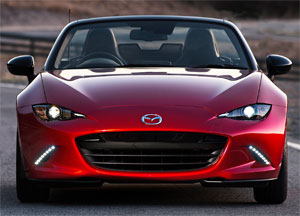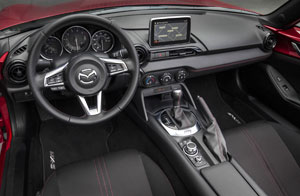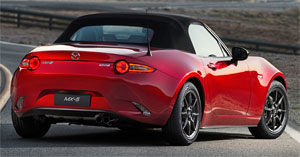2016 Mazda MX-5
For as long as we’ve been testing cars, we’ve yet to come across one that brings as much pure driving joy for the dollar spent as the Mazda Miata roadster. And even though it’s now officially the MX-5, and more and more sophistication has crept into the design over three generations, the all-new 4th gen, 2016 MX-5 keeps the good times rollin’.
It’s hard not to have a good time behind the wheel of the 2016 Mazda MX-5. As while this 4th iteration roadster may no longer look as far back, or be as basic, the pure sports car spirit of the original 1990 Miata is fully intact.
Like most recent Mazda’s, a significant effort is made to take the weight out, despite adding in more creature comforts. Weight is down 150-lbs. to 2,332.
And as before, there’s just enough go from the engine to make things fun, though now it’s the SKYACTIV-G 2.0-liter I4 at 155-horsepower and 148 lb-ft. of torque. A 6-speed manual transmission is standard, and it feels just as good as we remember. A 6-speed auto is available as well, but please only if you must.
At our test track, the MX-5 hops off the line better than ever. And while it’s easy to pine for more power, we’re actually quite happy with the engine’s output. It took 6.8–seconds to reach 60 on a slick track, and 15.4 to complete the ¼ at 89 miles-per-hour.
 When it comes to cone work, the first thing you notice is the new electric power steering. Turn in is still razor sharp and precise, there’s just a very light feel to it now, maybe too light. The car itself however, feels far more solid overall. Still, it’s just as entertaining as ever tossing it around with playful amounts of oversteer.
When it comes to cone work, the first thing you notice is the new electric power steering. Turn in is still razor sharp and precise, there’s just a very light feel to it now, maybe too light. The car itself however, feels far more solid overall. Still, it’s just as entertaining as ever tossing it around with playful amounts of oversteer.
The suspension remains double-wishbone front and multilink rear, but this time around, Club trim includes the sport suspension with Bilstein dampers and a shock tower brace; as well as a limited slip rear.
Averaging 60 MPH stopping distance of just 111–feet means the braking is done with the same no-nonsense efficiency as the rest of the car.
The leaner, meaner MX-5 has a much more modern look of course. It also sits lower, and is a hair wider.
The face is still friendly, but the rest of the car is a little edgier, almost BMW-like, with its Euro-esque sculpted rear. Both head and tail lights are full LEDs with LED DRLs of course.
Club trim adds a sharper-looking front air dam and black side mirrors; while the Brembo/BBS package really spices things up with painted calipers, side sill extensions, rear bumper skirt, and of course 17-inch forged BBS wheels.
True to tradition, a manual soft top is standard, folding and latching easily right from the driver’s seat. No word yet on whether an optional hardtop will return.
 Inside, available features abound, fully displayed here in Club trim, like a dash top 7-inch screen. Touch controls are limited to when you’re sitting still. This Commander Controller is use when moving. Push button start is standard. But the remainder of the interior, from round air vents to big analog gauges is as clean and simple as ever.
Inside, available features abound, fully displayed here in Club trim, like a dash top 7-inch screen. Touch controls are limited to when you’re sitting still. This Commander Controller is use when moving. Push button start is standard. But the remainder of the interior, from round air vents to big analog gauges is as clean and simple as ever.
Most importantly, the shifter falls readily to hand as always, and we quickly felt right at home. More comfortable seats with extra adjustments are always welcome, and they still hold you tight as well.
As for complaints, we understand the need of the Commander Controller, but its console placement is too far back for easy use, and we could use a little more girth to the steering wheel.
Mazda says that the MX-5’s trunk is smaller, but we actually found it more useful than before.
Government Fuel Economy Ratings for the manual are 27-City, 34-Highway, and 30-Combined. Even better are the numbers for the automatic at 27-City, 36-Highway, and 30-Combined. And they both share a great Energy Impact Score of 11.0-barrels of oil used and 4.9-tons of CO2 emissions per year.
 Prices have increased, now starting at $25,735 for Sport trim; this Club, at $29,420, and top shelf Grand Touring at $30,885. Still, no one else offers this much roadster fun for the dollar.
Prices have increased, now starting at $25,735 for Sport trim; this Club, at $29,420, and top shelf Grand Touring at $30,885. Still, no one else offers this much roadster fun for the dollar.
So, back to where we started. Even with all the improvements, Mazda has not compromised that great Miata persona. The 2016 Mazda MX-5 does indeed deliver a lot more than just sports car basics, but those basics are still what this little roadster gets exactly right.
Specifications
- Engine: 2.0 liter I4
- Horsepower: 155
- Torque: 148 lb-ft.
- 0-60 mph: 6.8 seconds
- 1/4 mile: 15.4 seconds @ 89 mph
- EPA: 27 mpg city/ 34 mpg highway
- Energy Impact: 11.0 barrels of oil/yr
- CO2 Emissions: 4.9 tons/yr
2024 Toyota Land Cruiser
Toyota’s Go Anywhere Globetrotter Returns To U.S.
Every once in a while, we all need a reset. A time to get back to basics and prioritize the things that really matter. Well, for the Toyota Land Cruiser that time is now. So, let’s find out if that means bigger and better things for Toyota’s iconic off-roader.
The Toyota Land Cruiser’s status among the global off-road community is legendary, and it’s hard to imagine there’s any corner of the earth where a Land Cruiser hasn’t kicked up a little dust or mud. Well, 2024 sees the return of the Land Cruiser to the U.S. market after a 3-year hiatus, getting a major reset for the journey.
The reset comes mostly by no longer being based on the large three-row “300-series” chassis, but a new version of the smaller “200-series,” now known as the J250. As with the latest Tacoma, it uses the Tundra pickup’s full-size steel frame.
While the main Land Cruiser model, which goes by simply Land Cruiser, is packed full of luxury and convenience features, there is also a stripped-down model known as the 1958, honoring the first year the Land Cruiser made landfall here in North America. And it is that 1958 we have here, and we were glad to see it, as it also celebrates the original’s back-to-basics approach as a blank canvas for you to personalize as you tackle more and more adventures.
Not that it’s fully stripped down, as 8-inch touchscreen infotainment, a 7-inch full-color multi-information display, and automatic climate control are still standard. Plus, some seriously durable materials, and great heated cloth front seats that throw off some get serious 1990s Tacoma vibes.
But outside, there’s a definite lack of flashy trim and basic looking 18-inch wheels with Yokohama Geolander all-season tires; plus, big chunky bumpers and tilt-up back glass, which is a rarity that we appreciate. Though there is a little too much plastic in places that are sure to see some abuse if you do any significant off-roading.
It even feels a little rough around the edges, but for us it just adds to the rugged old-school utility vibe in a good way.
We did just that, both here in the Mid-Atlantic as well as in the California desert; and while there are some tech-forward driving aids, the actual hardware is in most cases plenty to get things done. That includes standard full-time dual-range four-wheel-drive, locking center and rear diffs, and 8.7-inches of ground clearance. A front stabilizer bar disconnect is also available to allow for increased articulation.
Who needs a V6 or even a V8 when you’ve got Toyota’s i-FORCE MAX setup at your disposal with 326 horsepower and 465 lb-ft of torque coming from a 2.4-liter turbo-four with an electric motor sandwiched between the engine and its eight-speed automatic transmission. Low speed torque delivery is impressive. It even feels a little rough around the edges, which may be a turn off to some, but for us it just adds to the rugged old-school utility vibe in a good way.
And it certainly feels quicker than an off roader needs to be, with an instant torque dump as soon as we eased on the throttle at our Mason Dixon test track; helping us get to 60 in 8.1 seconds and through the quarter-mile in 16.3 seconds at 86 mph. Considering the Land Cruiser’s terrain conquering mission, it behaved quite well in our handling course; it was plenty responsive to inputs, with less body roll than we expected and plenty of grip from the tires. The steering was light and quick but as expected didn’t provide much feel. Other than significant nosedive, braking performance was exceptional. Only 107-feet to panic stop us from 60 mph.
With the shift to the smaller size, there’s no more third row available, and cargo capacity now comes in at 46.2 cubic-feet with a max of a still healthy 82.1. Now, the best part of the Land Cruiser’s return is the entry price of $57,445. That’s about 30-grand less than what the last Land Cruiser went for back in 2021.
Whether it’s over the top fashion trends, mullets, or zombies; just when you think they’re dead, they come roaring back to life. Of course, we’re much happier to see the resurrection of this 2024 Toyota Land Cruiser than any of those things. Toyota is one brand that still recognizes the value of full-framed rugged rigs and has also acknowledged that sometimes less really is more. The Godfather of Toyota off-roading is back and better than ever.







